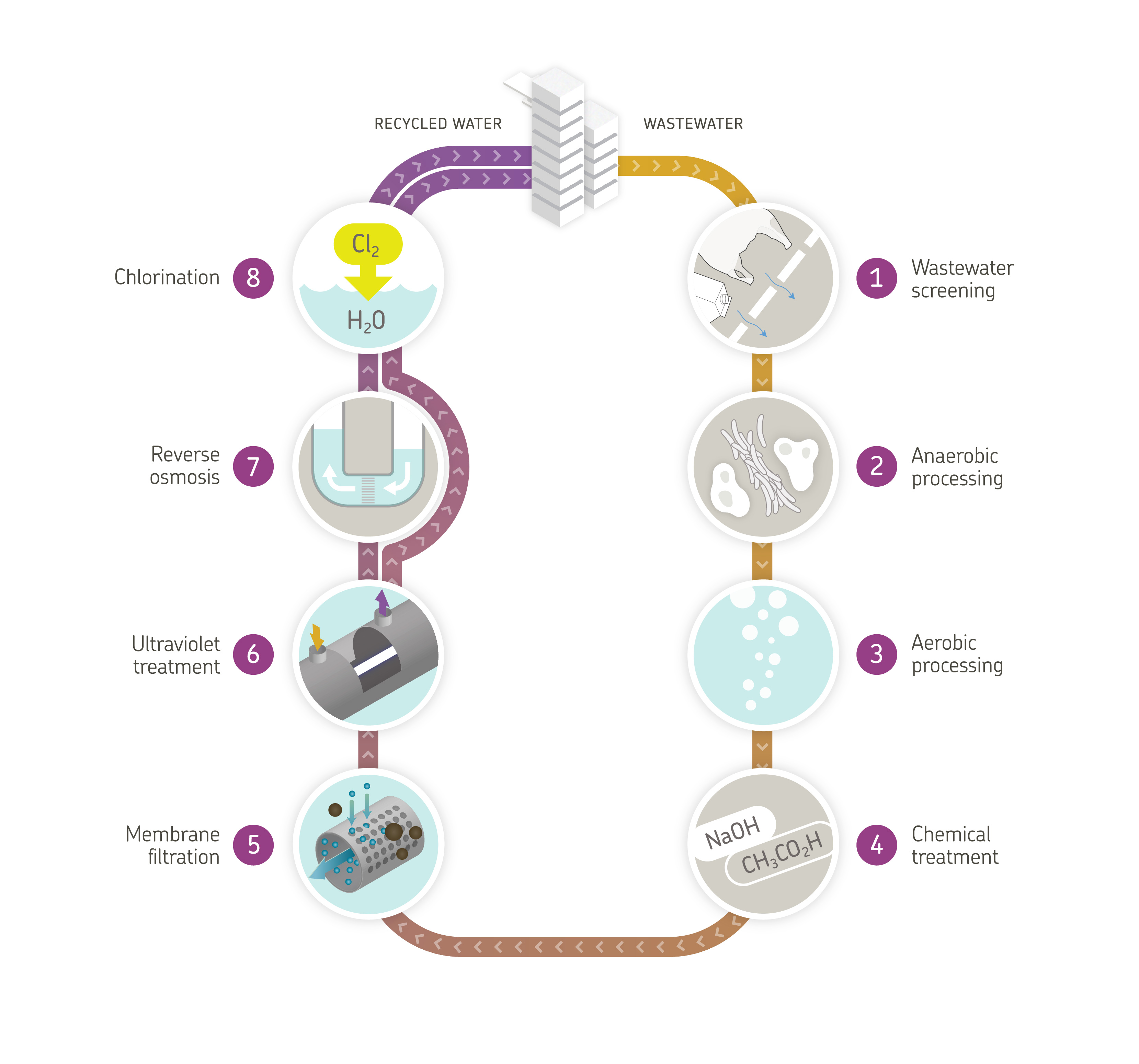case studies
Central Park recycled water scheme
Contact
Insight:
World’s biggest recycled water facility in the basement of a residential building
Project description
Basement collection, treatment and reuse of high wastewater in a high density urban development
A decentralised recycled water system has been delivered within a 5.8ha mixed use high density infill development site in Sydney. Wastewater is collected from precinct buildings (residential, commercial and retail) and an adjacent public sewer with top-up from stormwater runoff and rainwater. Wastewater is treated to the highest Australian standards using a membrane bioreactor (MBR) and reverse osmosis (RO). The recycled water is distributed within the precinct to supply water for cooling towers, irrigation, toilet flushing and washing machines. The scheme will also be exported across the road to University of Technology Sydney once the infrastructure (under construction at the time of writing) is completed.

The drivers
Raise the bar for sustainable living using ‘green technologies’ in a high density urban development
- Achieve a minimum 5 Green Star rating for each building
- Become Australia’s greenest and most self-sufficient mixed use urban development
The innovations
Biggest membrane bioreactor (MBR) recycled water facility in the world built in the basement of a residential building
- Decentralised wastewater treatment: Water is treated through eight filtration and purification processes including MBR and RO technologies. The treatment system requires minimal space and doesn’t generate noise or unpleasant smells so it can be incorporated into the basement levels of the building in a high density urban area.
- Remotely controlled: The wastewater treatment system has been designed to minimise operation and maintenance requirements so that it can be completely controlled remotely.
- Collecting and treating all forms of urban water: The system collects and treats wastewater from apartments, shops and offices. It also includes local rainwater and stormwater runoff, groundwater from the basement drainage systems and excess irrigation water from the gardens and green walls on-site.
- Fit-for-purpose use of water: Multiple pipelines are provided within the precinct to deliver water of a quality that is well suited to the intended use. This includes potable water from the closest water supply for drinking water and locally treated recycled water for toilet flushing, washing machines, irrigation, green wall watering, cooling towers, car washing and firefighting.
- Supported by local energy: An on-site central thermal tri-generation plant will provide energy for the wastewater treatment plant as well as the broader development.
The lessons
Privately operated decentralised water management
There is an ongoing debate about the use of centralised versus decentralised water management and the operation of privately run water utilities, but Central Park provides a good example of a decentralised system being operated by a private utility. Decentralised (or precinct-based) water recycling has been enabled in New South Wales following the introduction of the Water Industry Competition Act in 2006. This allowed private water industry companies to obtain a licence to supply water services to the community and operate water treatment facilities. Central Park Water, as the private water licence holder at Central Park, is subject to the same licensing requirements as Sydney Water (the public utility). The Independent Pricing and Regulatory Tribunal (IPART) and the Minister for Finance and Services oversee its administration and operation.
Transferability
New South Wales has unique bespoke legislation for local recycled water schemes, but there is nothing preventing these types of recycled water schemes in other states. The Water Industry Competition Act allows licensed New South Wales water utilities to also retail drinking water (sourced from state supplies). Some states have different rules around private sector retailing drinking water. Local regulations across Australia do not prevent on-site wastewater treatment systems.
Project stats
Location
Sydney, NSW, Australia
Participants
Awards
The scheme has received more than 50 awards.
See here
Topics
Additional information
Contact
The outcomes
 Cities providing ecosystem services
Cities providing ecosystem services

- Keeping wastewater out of the environment: 1 million litres of treated wastewater will be used in the development, instead of being discharged to receiving environments.
 Cities as water supply catchments
Cities as water supply catchments

- Alternative water supply: The recycled water plant will supply water to 2,000 residential apartments and 75,000m2 of commercial and retail space.
- Potable water savings: Residents will save up to 50% of potable water compared with typical developments.
 Cities comprising water sensitive communities
Cities comprising water sensitive communities

- Engaged customers: Water use monitoring and monthly e-bills keep residents aware of their water use.
Business case
| Costs | Benefits |
|
|
Interested in this solution?
We partner with small and large companies, government and industry in Australia and around the world.
Comments